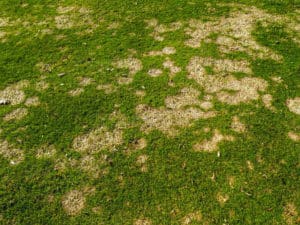With Mother Nature dropping close to 4 feet of snow this past winter in some parts of NJ, you might notice some strange things happening in your lawn this Spring as the snow melts away – but please, don’t be alarmed! It may not be as bad as you think. The culprit? SNOW MOLD!

What is Snow Mold?
Snow mold is a fungal lawn disease that occurs in the spring after the snow melts. It comes in two forms: pink fungus (potentially more damaging) and gray fungus. Snow Mold, which thrives under a layer of snow and isn’t noticed until Spring, is a lawn fungus that results in patches of dead grass in an otherwise healthy lawn. Not only is it unsightly, snow mold fungi can also trigger allergies and asthma attacks in people. If your grass was lush and green last fall, but dead spots are visible when warmer temperatures arrive, your lawn is a victim of snow mold.
It most commonly occurs if the first large snow falls on ground that hasn’t yet frozen. This creates a perfect blanket between grass and snow for fungus to grow from the spores that lay dormant throughout the rest of the season. This can be especially damaging if that area between snow and ground stays around the same temperature for a long time. That’s the ideal snow mold breeding ground.
How to Treat Snow Mold
The good news: Snow mold usually takes care of itself because it dies as temperatures increase. Gray mold dies at about 45 degrees Fahrenheit, and pink mold at about 60 degrees Fahrenheit. The effects of snow mold aren’t particularly extreme.
If you want to get rid of it faster:
- Mow the lawn as usual because tall grass is a great breeding ground for mold.
- Gently rake over straw-colored circles to dry out the area faster.
- Try to avoid putting fungicides on the lawn because they aren’t necessary if the grass heals itself.
- If you are receiving maintenance services from Borst Landscape & Design, we will be visiting your property soon for spring clean-ups. There, we will be using thatching rakes, which will help your lawn breathe again and make the problem go away much faster, followed with a fertilizer application to green things up.
